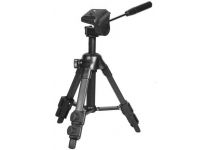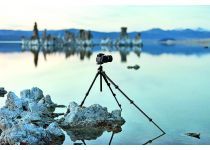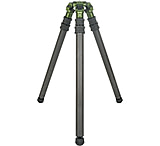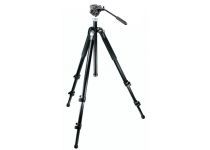 Tripods are an essential accessory for many types of optical equipment - spotting scopes, cameras, observation binoculars, telescopes and more. A tripod is used to improve steadiness when using high magnification instruments and/or support the weight of large, heavy instruments. Which tripod is right for you? Here are some basics to help you decide.
Tripods are an essential accessory for many types of optical equipment - spotting scopes, cameras, observation binoculars, telescopes and more. A tripod is used to improve steadiness when using high magnification instruments and/or support the weight of large, heavy instruments. Which tripod is right for you? Here are some basics to help you decide.![]()
For the sake of simplicity, think of tripods as having two basic parts - a tripod head, which holds your optical product and a tripod leg set. On less expensive tripods, typically under $100, tripod heads and tripod leg sets are sold together as a unit - no need to buy them individually. Most tripods in this price range do not allow you to remove and switch heads anyway. More expensive tripods, however, offer interchangeable legs and heads, so you may need to buy both pieces to make a complete tripod. If it is a leg set, only, there will only be specifications for a leg set. If a head and leg set are included, there will be specifications for both.
Big instruments and/or high magnifications require heavy tripod heads and these do not come cheap. Be sure to budget for a tripod that matches your instrument and needs. Anything less is a waste of money. Indeed, most tripods under $100 have plastic heads, which can crack and drop your expensive camera or spotting scope on the ground without warning. Cheap tripods are only suitable for small loads and small instruments.
Some manufacturers offer weight or payload capacities of their tripods. These should not be taken too literally and are nearly always inflated. Payload specs can be used as a basis for comparison, but rarely translate into anything real in actual use. A tripod or head rated for 13 pounds DOES NOT automatically make it a good choice for a 13 lb giant binocular.
What Are the Different Types of Tripods?
Compact Tripods
In terms of height, compact tripods begin where table top tripods end. A compact tripod tends to be a bit too large to use conveniently on a table, but will becomfortable to use when sitting in a chair. Compact tripods are the favorites of backpackers and mountain hunters who are willing to sacrifice height for portability. Compact tripods are ideal for spotting scopes of 70mm or smaller and for any digital point camera, but are not good choices when you need to stabilize 80mm and larger spotting scopes or SLR cameras with telephoto lenses.
Full-Size Tripods
A full size tripod allows a user of average height to use a spotting scope, binocular or camera while standing. Full size, however, does not automatically mean heavy duty. As always, you should match tripod weight and strength with the size and weight of the spotting scope, binocular or camera. Keep in mind, there is no such thing as a tripod that is both "cheap" and "stable". The larger the load on a tripod, the more you should expect to pay to do the job, properly. The average full size tripod with head attached, extends from about 26" to 57" with legs fully extended, center column down, and up to 72" with the center column at its highest.
Table Top/Shooter's Tripods
As the name indicates, a table top tripod is designed to be used on a table or a shooting bench and will typically be between 8" and 18" in height, depending on the model. Table top tripods in this category generally do not have telescoping legs - what little range of adjustment they have is through an extendable center column, though many tabletop models lack even this. A shooter's tripod is basically a short table top tripod with a knob(s) for fine adjustments in elevation and sometimes windage (horizontal). Due to their lighter weight and rather narrow width of leg span, table-top tripods are a good choice where space is limited, but for the same reasons, table top tripods are not good choices for heavy, large instruments.
Everything You Should Know About Tripod Heads
When focusing on a tripod head, you need to consider what type of motion it provides and the weight it will support. Other features are optional. As far as how they move, tripod heads fall into three general categories: two way tripod heads, three way tripod heads, and tripod ball heads. The one you choose is mostly a matter of your application and optical instrument, but there is a great deal of overlap. For instance, you can use a spotting scope on any type of head and you can also use a camera on any type of head. Why? Because most tripods heads, cameras spotting scopes, and binocular tripod adapters use the same 1/4x20 thread to attach to the tripod head. It's universal, so you do not need to match a brand of tripod with a brand of spotting scope, camera and so on.
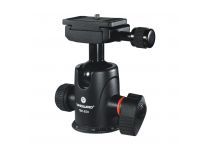 The single biggest mistake beginners make is selecting a tripod that is too light for a given optic or task. The heavier and the higher the magnification of the optical instrument you are attaching to the tripod, the more important the weight and size of tripod heads. The main issue is sag or flex in the head and parts. Put a giant binocular on a light head, find an object, lock the head on the target, let go and look through the binocular. The target will not be in the field of view because the head sagged under the load.
The single biggest mistake beginners make is selecting a tripod that is too light for a given optic or task. The heavier and the higher the magnification of the optical instrument you are attaching to the tripod, the more important the weight and size of tripod heads. The main issue is sag or flex in the head and parts. Put a giant binocular on a light head, find an object, lock the head on the target, let go and look through the binocular. The target will not be in the field of view because the head sagged under the load.
The situation is worse when you add more magnification, because we are not only magnifying an object, but also every little vibration, shake or tremor in the optical system. At 60x, even a slight breeze can render an expensive spotting scope useless if mounted on a cheap tripod.
Two Way Tripod Heads
A two way tripod head is the most basic tripod head and is sometimes called a video head or camcorder head. A two-way head, as the name suggests, allows you to move the head vertically and horizontally. This is all you need with a spotting scope, video camera, giant binocular and many types of camera applications. Two-way heads are usually the simplest and most stable.
Three Way Tripod Heads
A three-way tripod head adds an extra motion to the basic two-way head. In addition to up-down and right-left, three-way heads allow you to flip a camera on its side. This allows a photographer to change from a horizontal frame pic to a vertical frame pic. This same feature can also be used by a photographer to take pictures of objects below the tripod. Thus, a three-way head is mostly of interest to a photographer, but, again, you can use this tripod head with any kind of optical instrument, including spotting scopes and binoculars. You do not have to use the three way feature if you don't need it.
Tripod Ball Heads
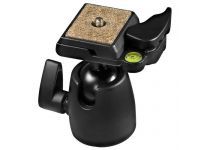 As the name suggests, a ball head tripod is a head on top of a ball. This allows you to move the head in any direction with one motion. For instance, to target an object both up and off to the side with a two way or three way head, you must move the head up in one motion and then over in another, separate motion. With a ball-head, you can accomplish this with one motion. Ball-heads come in several varieties - some lock with conventional levers, some lock with a trigger. Keep in mind, however, that all but the largest (and most expensive) ball-head tripods are not as stable and cannot support as much weight as a good two way head. Ball heads also sit higher on the leg set than two way and three way heads. This can create balance problems with heavy loads. In a tripod, stability should always come, first.
As the name suggests, a ball head tripod is a head on top of a ball. This allows you to move the head in any direction with one motion. For instance, to target an object both up and off to the side with a two way or three way head, you must move the head up in one motion and then over in another, separate motion. With a ball-head, you can accomplish this with one motion. Ball-heads come in several varieties - some lock with conventional levers, some lock with a trigger. Keep in mind, however, that all but the largest (and most expensive) ball-head tripods are not as stable and cannot support as much weight as a good two way head. Ball heads also sit higher on the leg set than two way and three way heads. This can create balance problems with heavy loads. In a tripod, stability should always come, first.
What Are the Different Parts of Tripod Legs?
Most tripod legs telescope in and out to accommodate various heights, but there is a limit to the range of heights a single tripod leg set can handle. For instance, there is no such thing as a tripod that can be fold down to the size of a compact tripod, then extend out to the height of a full size tripod. The problem is the number of leg sections required - the more sections used, the less stable the tripod. In theory, you could make a standing height tripod with 6 leg sections that would collapse to 12" or so, but such a tripod would be very unstable at full height and that defeats the very reason for using a tripod. Most full size tripods, therefore, limit the number of leg sections to three or, at most, four. That's enough to cover all uses from sitting to standing. In general, you can divide tripods into four categories, based on their range of extension and/or use.
Materials
The traditional tripod leg material is aluminum and it is always a solid choice. To shave weight, carbon fiber legs are also used. The carbon fiber leg is also less prone to vibrations and shakes and is a great choice for high magnification photography and spotting scopes. Carbon fiber, however, compared to aluminum, is very expensive and the weight savings will generally one pound or less than the same model offered in aluminum.
Locks
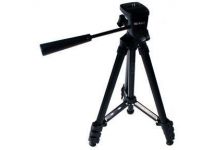 Tripod legs are extended and then locked into position with various mechanisms. The slowest, but most durable locks are a simple wing nut or a twist collar that must be tightened for each tripod leg section. For some applications, such as birding or hunting, where you may need to get setup quickly, this may be a bit slow. Lever locks are much quicker. Simply flip a lever and the leg section is fully locked - no tightening needed. If good quality, lever locks are quite durable. Lever locks on cheap tripods, however, are notoriously prone to failure - usually the first thing to go.
Tripod legs are extended and then locked into position with various mechanisms. The slowest, but most durable locks are a simple wing nut or a twist collar that must be tightened for each tripod leg section. For some applications, such as birding or hunting, where you may need to get setup quickly, this may be a bit slow. Lever locks are much quicker. Simply flip a lever and the leg section is fully locked - no tightening needed. If good quality, lever locks are quite durable. Lever locks on cheap tripods, however, are notoriously prone to failure - usually the first thing to go.
Braces
These are arms that connect the lower portion of some tripod legs. The idea is to add support and rigidity. Leg braces are suitable for locations with a smooth, level surface, such as a photography studio or a living room, lawn and so on, but tripods with leg braces are not suited for use around rocks, bushes, and other objects. The braces will jam against large objects beneath the tripod and may even prevent you from using your tripod. Not a feature you want or need out in the field.
What Are Common Tripod Features?
Thread Size
The standard thread size is 1/4x20 on all cameras, up through SLR size, all spotting scopes, and all binoculars and binocular tripod adapters. Unless otherwise specified, this is the size of the mounting stud on all of our tripods. In other words, any tripod will thread to any spotting scope, camera up through SLR (cameras with removable lenses) and binoculars. The only exception to this 1/4x20 standard is the larger 3/8x16 thread size used to support some larger format cameras and video/camcorder units, survey equipment and so on.
Quick-Release Plate (QR)
This is a plate that goes between the tripod head and your camera, spotting scope or any other optical instrument. A QR plate eliminated the need to thread and un-thread your optic from the tripod head every time you use the tripod. You simply thread the QR plate onto your spotting scope or camera and leave it there. When it's time to put your spotting scope or camera on the tripod, you just slip the QR plate into the head, simply and quickly. Note that QR plates are specific not only to brands, but also to specific models within a brand. They are not universal in size.
Bubble Level
This is a feature mainly of interest to a photographer to insure that a subject is properly framed and leveled in the camera, but is not always used, even for photography. It has no essential application for spotting scopes or binoculars.
Center Columns
Nearly all full size and compact tripods offer an extendable center column to get more height, but height achieved via the center column is never as stable as height achieved with the legs. Use only as needed. Center columns can be elevated via a geared system or pulled up, manually. Geared center columns allow micro fine elevation adjustments and are preferred by some photographers, but are not needed for most field applications and add unnecessary weight. A simple pull-up design with a sturdy lock is the best choice for field work.
Leg Warmers
Many of the better tripods have a layer of foam on the top section of the legs. This cushions the leg when the tripod is carried over your shoulder, as is often the case with spotting scopes and cameras, out in the field and, yes, it keeps a metal leg from touching you in cold weather. Nice feature.
Tripod Feet
Spiked feet are the traditional type of foot used out in the field for the sake of traction, but not something you want to use in a studio or living room. For these applications, a rubber foot is a much better choice. Many tripods therefore offer a retractable spiked foot, which can be threaded back into the leg. That way you get both a spike and a rubber foot.





